-
Paper Information
- Next Paper
- Paper Submission
-
Journal Information
- About This Journal
- Editorial Board
- Current Issue
- Archive
- Author Guidelines
- Contact Us
American Journal of Medicine and Medical Sciences
p-ISSN: 2165-901X e-ISSN: 2165-9036
2022; 12(4): 399-403
doi:10.5923/j.ajmms.20221204.07
Received: Mar. 26, 2022; Accepted: Apr. 12, 2022; Published: Apr. 16, 2022

Screening of Psychoemosional Disorders in Patients with Second Type of Diabetes - A New Psychodiagnostic Approach to Typical Diagnosis and Treatment
Ibodullayev Bekhzod Bakhromovich
Assistant of the Department of Neurology and Psychiatry, Urgench branch of the Tashkent Medical Academy, Uzbekistan
Correspondence to: Ibodullayev Bekhzod Bakhromovich, Assistant of the Department of Neurology and Psychiatry, Urgench branch of the Tashkent Medical Academy, Uzbekistan.
Copyright © 2022 The Author(s). Published by Scientific & Academic Publishing.
This work is licensed under the Creative Commons Attribution International License (CC BY).
http://creativecommons.org/licenses/by/4.0/

This article discusses the study of the structure of psycho-emotional disorders using effective psycho-diagnostic methods in the diagnosis of psycho-emotional disorders in patients with type 2 diabetes mellitus and the use of effective medical and psychological methods in therapeutic processes and treatment effectiveness.
Keywords: Diabetes, Depression, Anxiety, Stress, Psychotherapy
Cite this paper: Ibodullayev Bekhzod Bakhromovich, Screening of Psychoemosional Disorders in Patients with Second Type of Diabetes - A New Psychodiagnostic Approach to Typical Diagnosis and Treatment, American Journal of Medicine and Medical Sciences, Vol. 12 No. 4, 2022, pp. 399-403. doi: 10.5923/j.ajmms.20221204.07.
1. Intoduction
- Today, chronic and progressive diseases are becoming more widespread in our region, and one of the diseases that is becoming a global medical-social and medical-psychological problem today is the second type of diabetes. According to the World Health Organization (WHO), 8.8% of the world's population is diagnosed with the disease. According to the seventh edition of the 2015 Atlas of the International Association of Diabetologists (IDF Atlas diabetes 7 7 st publication), the number of patients with type 2 diabetes was 415 million, and by 2040 this figure will reach 642 million. It has become a global problem in the health care system, with experts predicting that the disease will become the seventh leading cause of death by 2030. [2] Analysis of diabetes mellitus in Uzbekistan until 2019 showed that the total number of patients diagnosed with diabetes was 230,610, of which 18,349 were type 1 QD, and the remaining 212,261 were type 2 [3]. Type 2 diabetes is not only a medical and social problem today, but also one of the highest medical and psychological problems. Studies show that 80% of patients with type 2 diabetes suffer from some form of psychopathological disorder [4,5]. These psychopathological disorders include affective disorders, cognitive disorders, and a stressful nature. The development of psycho-emotional disorders in patients with type 2 diabetes, i.e., depression, anxiety and stress disorders, can lead to a decrease in the effectiveness of treatment, as well as various life-threatening complications, which can lead to life-threatening complications. This, in turn, requires early psycho-diagnostic-screening of psycho-emotional disorders developed in patients and the timely provision of effective medical and psychological care [6,7,8].
2. Objective
- To use modern psycho-diagnostic methods in the screening of psycho-emotional disorders in patients with type 2 diabetes treated in the endocrinology department of the clinic of the Urgench branch of the TTA and to conduct effective medical and psychological correction.
3. Materials and Methods
- The TTA was conducted in the endocrinology department of the Urgench branch in 116 patients being treated for type 2 diabetes. Of these, 53 were men and 63 were women. The patient group consisted of individuals aged 39–75 years, with an average age of 62.8 + 0.7. A special medical-psychological questionnaire was used to assess the mental status of our patients. In assessing the psycho-emotional sphere in patients, the following psychometric tests were used in our study:1. Pre- and post-treatment indicators using the psycho-diagnostic questionnaire DASS-42 (Manual for the. Depression Anxiety Stress Scales 2nd.Ed), which simultaneously detects the development of depression, anxiety and stress disorders in patients in order to assess the psycho-emotional sphere compared.2. A Yung questionnaire was used to assess the personality traits of patients.In our study, psycho-correction of psycho-emotional disorders was carried out by dividing patients into two groups:Group 1: Psychotherapeutic n - 58 based on basic treatment and rational emotional psychotherapy for patients in this group. The algorithm was used:Group 2: Basic treatment and rational psychotherapy were used in patients in this group: n - 58.Rational psychotherapy and rational-emotional psychotherapy were selected from the psychotherapeutic methods performed on patients, the distribution of our patients was as follows: (Table 1)
|
4. Results
- The following results were obtained using psycho-diagnostic surveys conducted to determine the structure of advanced psycho-emotional disorders in our patients. According to the survey, the following structure was formed in the assessment of psycho-emotional disorders in our patients, depressive, anxiety and stress disorders on the basis of the questionnaire DASS-42, statistical analysis of pre-treatment and post-treatment indicators based on diagrams and tables.Psychometric test results in our patients according to the questionnaire DASS - 42 levels of depressive disorders obtained before and after treatment.
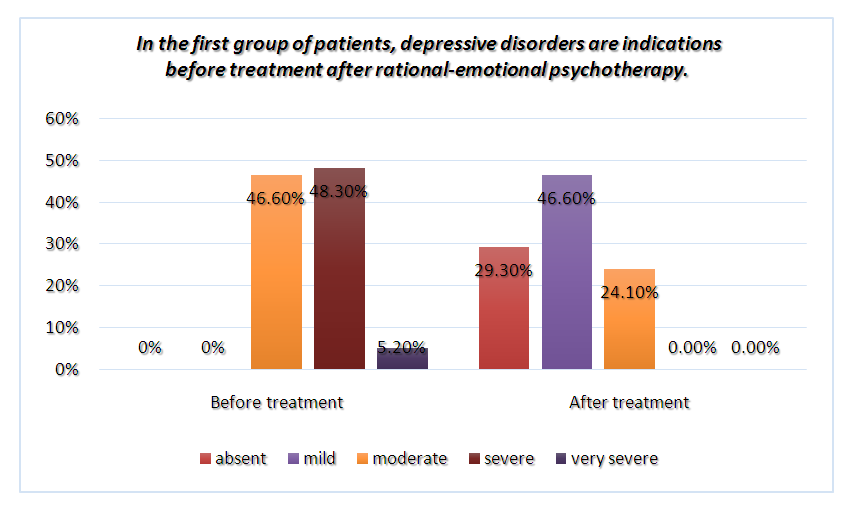 | Figure 1 |
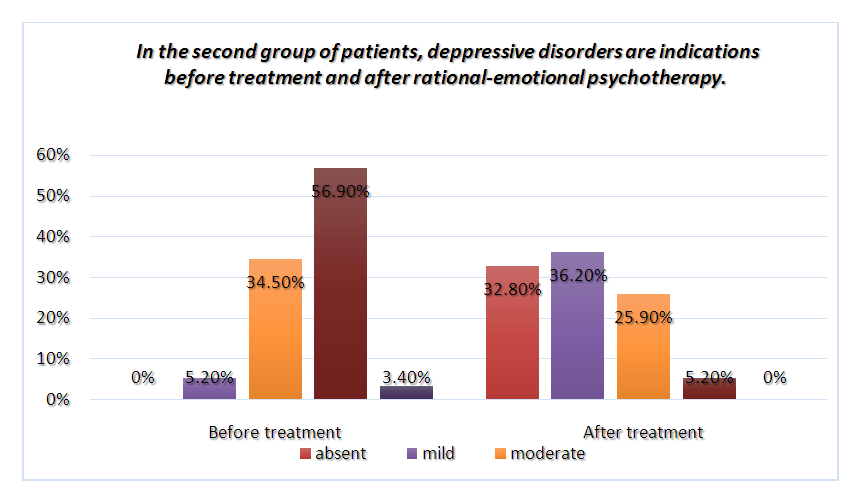 | Figure 2 |
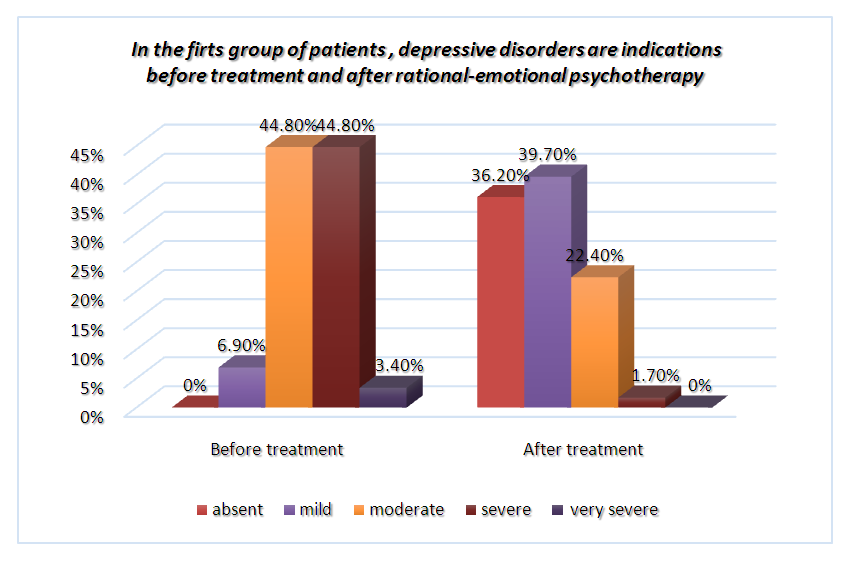 | Figure 3 |
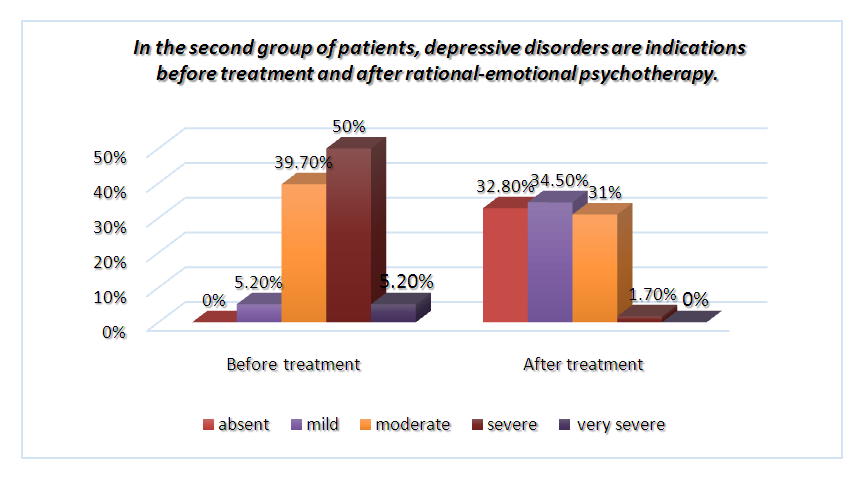 | Figure 4 |
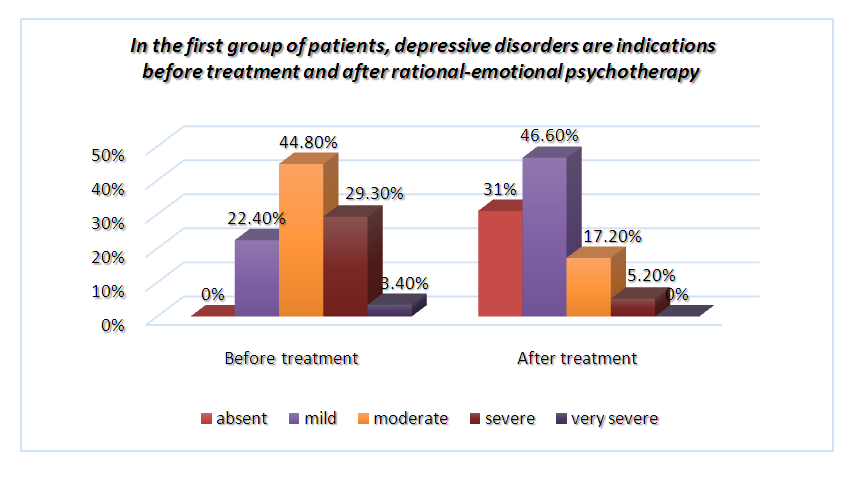 | Figure 5 |
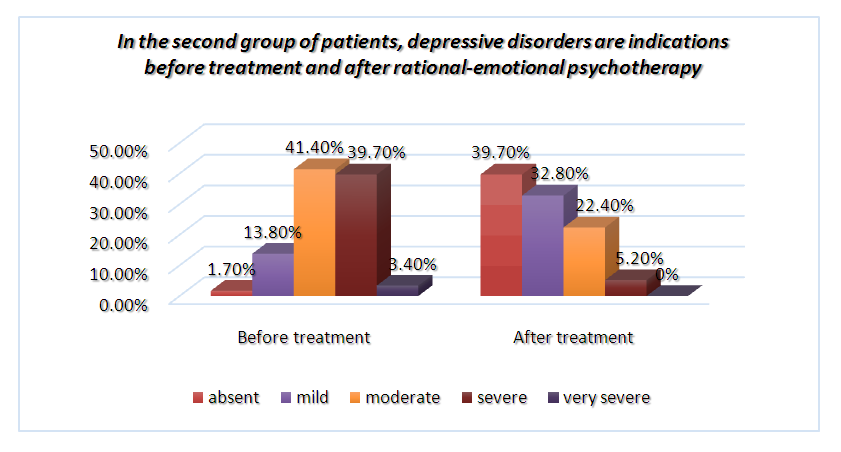 | Figure 6 |
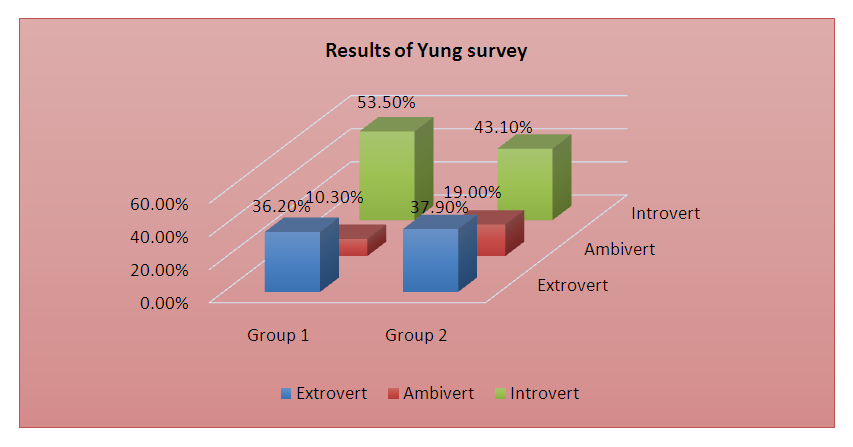 | Figure 7 |
5. Conclusions
- From the above results, it can be concluded that the role of psychodiagnostics in the timely diagnosis of psycho-emotional disorders in patients with type 2 diabetes, the analysis of the psychological status of each patient, as well as in assessing the effectiveness of psychotherapy.Second, during the provision of medical and psychological care to our patients, it was found that the method of psychotherapy, rational-emotional psychotherapy, used to correct psycho-emotional disorders in the first group of patients, was more effective than rational psychotherapy in the second group. Our observations prove that rational-emotional psychotherapy in patients is a method of choice psychotherapy in the correction of psycho-emotional disorders.
 Abstract
Abstract Reference
Reference Full-Text PDF
Full-Text PDF Full-text HTML
Full-text HTML